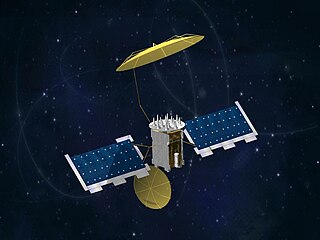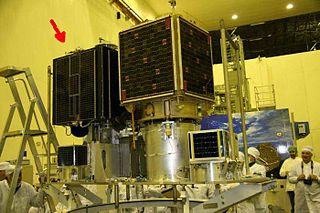UoSAT-2, which is also known as UO-11 and OSCAR-11, is a British satellite orbiting in Low Earth Orbit. The satellite functions as an amateur radio transmitter and was built at the University of Surrey. It launched into orbit in March 1984 and remains orbital and active, though unstable with irregular periods of transmission. All of the Analog telemetry channels have failed, making telemetry from OSCAR 11 useless. The satellite was still heard transmitting telemetry in 2015, thirty years after launch.

A small satellite, miniaturized satellite, or smallsat is a satellite of low mass and size, usually under 1,200 kg (2,600 lb). While all such satellites can be referred to as "small", different classifications are used to categorize them based on mass. Satellites can be built small to reduce the large economic cost of launch vehicles and the costs associated with construction. Miniature satellites, especially in large numbers, may be more useful than fewer, larger ones for some purposes – for example, gathering of scientific data and radio relay. Technical challenges in the construction of small satellites may include the lack of sufficient power storage or of room for a propulsion system.

The Mobile User Objective System (MUOS) is a United States Space Force narrowband military communications satellite system that supports a worldwide, multi-service population of users in the ultra high frequency (UHF) band. The system provides increased communications capabilities to newer, smaller terminals while still supporting interoperability with legacy terminals. MUOS is designed to support users who require greater mobility, higher bit rates and improved operational availability. The MUOS was declared fully operational for use in 2019.

EgyptSat 1 or MisrSat-1 was Egypt's first Earth remote sensing satellite. This satellite was jointly built by Egypt's National Authority for Remote Sensing and Space Sciences together with the Yuzhnoye Design Bureau in Ukraine and was launched on board a Dnepr rocket on 17 April 2007 from the Baikonur Cosmodrome.
The Briz-K, Briz-KM and Briz-M are Russian liquid-propellant rocket orbit insertion upper stages manufactured by Khrunichev State Research and Production Space Center and used on the Proton-M and Angara A5. The upper stages were also used on Rokot, one of Russia's smaller launchers, before its retirement in 2019.
ChinaSat is the brand name of communications satellites operated by China Satellite Communications.

NanoSail-D2 was a small satellite built by NASA's Marshall Space Flight Center and Ames Research Center to study the deployment of a solar sail in space. It was a three-unit CubeSat, measuring 30 cm × 10 cm × 10 cm with a mass of 4 kg (8.8 lb). Its solar sail had an area of 10 m2 (110 sq ft), and was deployed in around five seconds.

Several new rockets and spaceports began operations in 2016.

KickSat was a satellite dispenser for small-satellite (femtosatellite) project inaugurated in early October 2011, to launch many very small satellites from a 3U CubeSat. The satellites have been characterized as being the size of a large postage stamp. and also as "cracker size". The mission launch was originally scheduled for late 2013 and was launched April 18, 2014.
Technology Education Satellite (TechEdSat) is a successful nano-sat flight series conducted from the NASA Ames Research Center in collaboration with numerous universities. While one of the principal aims has been to introduce young professionals and university students to the practical realm of developing space flight hardware, considerable innovations have been introduced. In addition, this evolving flight platform has tested concepts for Low Earth Orbit (LEO) sample return, as well as planetary nano-sat class mission concepts.
SkySat is a constellation of sub-meter resolution Earth observation satellites owned by Planet Labs, providing imagery, high-definition video and analytics services. Planet acquired the satellites with their purchase of Terra Bella, a Mountain View, California-based company founded in 2009 by Dan Berkenstock, Julian Mann, John Fenwick, and Ching-Yu Hu, from Google in 2017.

Planet Labs PBC is an American public Earth imaging company based in San Francisco, California. Their goal is to image the entirety of the Earth daily to monitor changes and pinpoint trends.
Perseus-M is a pair of microsatellite developed by Russian-American company Dauria Aerospace and launched in 2014. The satellite is built in 6U Cubesat bus (0.3x0.2x0.1m), optimized for piggy-back launch. All instruments are powered by solar cells mounted on the one side of spacecraft, providing approximately 6W average power.
Satellogic is a company specializing in Earth-observation satellites, founded in 2010 by Emiliano Kargieman and Gerardo Richarte.

The following is a timeline of important events in the history of private spaceflight, including important technical as well as legislative and political advances. Though the industry has its origins in the early 1960s, soon after the beginning of the Space Age, private companies did not begin conducting launches into space until the 1980s, and it was not until the 21st century that multiple companies began privately developing and operating launch vehicles and spacecraft in earnest.

BulgariaSat-1 is a geostationary communications satellite operated by Bulgaria Sat and manufactured by SSL. The satellite will provide high definition and ultra-high-definition television, very-small-aperture terminal (VSAT) communications, satellite news gathering relays, and other communications services, primarily to the Balkan Peninsula and Central/Western Europe.

ÑuSat satellite series, is a series of Argentinean commercial Earth observation satellites. They form the Aleph-1 constellation, which is designed, built and operated by Satellogic.

Nigeria EduSat-1 was a Nigerian nanosatellite built by the Federal University of Technology Akure (FUTA), created in conjunction with the Japanese Birds-1 program. It was Nigeria's first satellite built by a university. It was launched from the Japanese Kibō module of the International Space Station.










